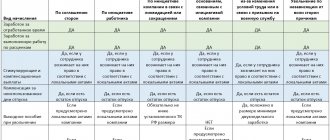Upon termination of the employment relationship, in addition to the salary for the work done, the employee may need to be given a number of amounts not related to the direct performance of work duties. To accrue them, you must first according to certain rules. Moreover, in some non-standard situations, special calculation algorithms are used to ensure that the employee’s rights are fully respected.
Also see:
- How the Labor Code of the Russian Federation regulates dismissal while on vacation
- How to correctly calculate the number of vacation days for compensation upon dismissal
In what cases are average earnings calculated upon dismissal?
At the moment of completion of cooperation with the employee, a full payment is made to him. In addition to the salary amount, the resigning employee must be accrued:
- Compensation for the remainder of the vacation (if any) that was not used (part 4 of article 84.1, part 1 of article 127, part 1 of article 140 of the Labor Code of the Russian Federation).
- Dismissal benefits if the employment relationship was terminated for certain reasons (Article 178 of the Labor Code of the Russian Federation).
IMPORTANT!
Severance pay is required to be given to all employees leaving the organization due to optimization of the number of employees or closure of the company. The exception is those who were accepted for a period of up to 2 months. However, this does not deprive the company of the opportunity to include conditions for additional payments to this category of personnel in its internal regulations.
Severance pay is due:
1. Upon dismissal due to the closure of an organization or a reduction in the number of staff :
- in the amount of average earnings for the first month after termination of the employment contract;
- in the amount of average earnings for the second month after dismissal - provided that the dismissed person was unable to find a job and received official unemployed status;
- in special circumstances, by decision of the employment service - for the third month after termination of the employment contract, and for workers in the Far North, it is possible to increase the time of payments to 5 months .
2. In other circumstances of dismissal, benefits may be paid in the amount of two weeks’ average earnings. This:
- conscription into the army;
- rupture of cooperation due to changes in working conditions that make it impossible to continue;
- dismissal due to refusal to move to a workplace in another region;
- worker's medical care indications;
- dismissal due to the return of a previously departed employee on the basis of a judicial act.
Thus, calculating average earnings per day is necessary in all of the above cases.
How to calculate the average monthly salary of a specialist upon dismissal
The amount of average monthly earnings is important when a trade union is terminated due to the liquidation of an enterprise or staff reduction. In accordance with stat. 178 such employees are entitled to severance pay for two, and in some cases, 3 months. How to calculate the amount of such a salary?
As when determining average earnings per day, it is necessary to be guided by the provisions of the stat. 139 TK. This means that any calculation of average data involves calculating the total income accrued to the specialist in fact and the production time for the previous 12 months. The formula looks like this:
SMZ = Total salary / 12 months.
Sometimes an employee needs a certificate from social security authorities to confirm their income level. In this situation, you usually need to draw up a document indicating the specialist’s income for 3 or 6 months. To determine the indicator, the total salary for the period is taken and divided by the number of months.
What standards govern the calculation of average daily earnings?
Here are the legal norms on the basis of which the average daily earnings are calculated upon dismissal:
- Art. 139 Labor Code of the Russian Federation;
- Decree of the Government of the Russian Federation dated December 24, 2007 No. 922 “On the specifics of the procedure for calculating average wages.”
According to them, average daily earnings must be calculated for a period of 12 consecutive calendar months, up to the month in which the basis for the corresponding accrual arose.
In general, the procedure for calculating it includes:
1. Determination of the calculation period and the quantity related to it:
- calendar days - to calculate payments for vacation not taken;
- working days - to calculate severance pay.
2. Summarizing the salary that needs to be taken into account.
3. Dividing the salary amount by the duration of the pay period in days.
What does severance compensation mean?
When talking about compensation for leave upon dismissal, we usually mean its most general case, which applies to absolutely all employees.
This is compensation upon dismissal in the form of vacation pay due for vacation not used during the period of work. Every employee has the right to annual paid leave, and at the time of dismissal, part of it (and sometimes even several years of leave) may be unused. Art. 127 of the Labor Code of the Russian Federation obliges to pay this part in case of dismissal, no matter what its actual duration turns out to be. The reason for termination of the employment contract does not matter when calculating compensation upon dismissal. How to calculate days of compensation upon dismissal? The duration of standard annual leave is 28 calendar days (Article 115 of the Tax Code of the Russian Federation). However, for some categories of workers it is extended (Articles 116–119, Article 348.10 of the Labor Code of the Russian Federation). Vacation pay upon dismissal is calculated based on the length of vacation that is due to a particular person, taking into account the extension, if any. Holidays do not include holidays.
The beginning of the year to which the annual leave will relate is determined individually by each employer for each specific employee - from the first day of his employment for this job (clause 1 of the Rules on regular and additional leaves, approved by the People's Commissar of the USSR on April 30, 1930 No. 169), and the end may be shifted if, during the calendar year calculated from the starting date, the employee experienced periods that were not included in this length of service (Article 121 of the Labor Code of the Russian Federation).
Calculation of compensation for dismissal in 2021 is also carried out for persons signed under a fixed-term (up to 2 months) employment contract (Article 291 of the Labor Code of the Russian Federation) or for part-time work (Article 93 of the Labor Code of the Russian Federation). For a fixed-term contract, vacation pay is calculated based on the fact that each month worked corresponds to 2 working days of vacation.
There is no need to accrue compensation for unused vacation upon dismissal to employees:
- drawn up under a GPC agreement (Article 11 of the Labor Code of the Russian Federation);
- those who worked less than half a month (clause 35 of the Rules on regular and additional leaves, approved by the People's Commissariat of Labor of the USSR on April 30, 1930 No. 169).
The accrued compensation upon dismissal is subject to insurance premiums, personal income tax and is paid along with other amounts due to the employee on the last day of his work activity (Article 140 of the Labor Code of the Russian Federation).
ConsultantPlus experts have made an analytical selection on legal disputes with employees regarding the payment of dismissal compensation. Get trial access to the system and find out court decisions on the most common questions.
Read about whether it is possible to receive vacation pay compensation without resorting to dismissal.
What periods and amounts are included in the calculation of average earnings?
Regardless of the purpose for which the calculation is made, the following days are not taken into account in 12 months:
- when an employee was released from performing official functions while maintaining his salary;
- related to sick leave time;
- periods when the employee did not work and received average earnings.
Bonus payments are included in the calculation of the average salary, regardless of the presence of excluded periods, if they are calculated taking into account the time worked. Otherwise, they must be taken into account as a share of the time actually worked.
IMPORTANT!
Monthly bonuses are taken into account in the actual amount, but no more than one monthly payment for each individual indicator.
Bonuses for quarters that are fully taken into account in the period of calculating average earnings are accepted in full . Otherwise, they are included in proportion to the number of months in the quarter included in the 12 months before the month in which average earnings are calculated.
Annual bonuses for the previous year are taken into account in full , regardless of the time of their payment.
IMPORTANT!
An exception to the general rule is financial assistance for vacation, which is taken into account when calculating average monthly earnings upon dismissal (Resolution of the Presidium of the Supreme Arbitration Court of the Russian Federation dated November 30, 2010 No. 4350/10).
Features of calculating average daily earnings upon dismissal
Since the amount of payments for performing work duties may vary, the Government of the Russian Federation has developed regulations for determining average earnings. Resolution No. 922 of December 24, 2007 states that the average salary is calculated in all situations that are provided for by the labor legislation of the Russian Federation. In particular, this happens in connection with a reduction in the company's workforce, during the liquidation of an enterprise, or when a specialist is dismissed.
This is also important to know:
Dismissal of a pensioner: is it legal and how to formalize the dismissal?
How to calculate average daily earnings upon dismissal? Next, let's see how to calculate the indicator.
Basic rules for calculating SDZ:
- Regardless of what operating mode is in effect at the enterprise, the calculation takes into account wages for the year, that is, for the 12 months preceding the moment the payment is calculated. In this case, only the actual time worked and the actual accrued salary are taken. A calendar month is defined as the period from the 1st to the last day of the month.
- The following are subject to exclusion from the billing period, as well as from the accrued salary: cases of continued earnings; cases of disability, maternity leave; downtime due to the fault of the enterprise (for independent reasons); periods of strikes; unpaid holidays; paid additional days provided for the purpose of caring for disabled children; periods of release from work duties with full or partial retention of earnings.
- If the billing period is not fully worked out, the actual earnings for the time worked are taken into account.
- The use of SDZ is allowed when calculating vacation pay, and the average daily earnings are also taken when calculating compensation for unused vacations.
- The formula for calculating SDZ takes the average monthly number of days equal to 29.3.
- When calculating the amount of earnings, you should take into account all types of remuneration to staff for performing work duties according to the organization’s SOT (remuneration system). The source of the salary does not matter.
Base for calculating average earnings
The next indicator necessary to calculate the average daily earnings for compensation upon dismissal is the base. This is the sum of all employee payments for the period defined as settlement.
Not all employee benefits need to be included in the calculation. Only income that is directly related to the performance of work duties is subject to accounting.
You need to include in the average earnings base:
- salary;
- bonuses accrued based on the results of various periods (month, quarter, half-year, year) are taken into account in a special order, which is described below;
- other incentive payments for labor achievements, according to the bonus system.
This is also important to know:
Should sick leave be paid after dismissal?
All other accruals are not subject to inclusion in the calculation of average daily earnings for compensation. That is, there is no need to take into account vacation pay, compensation for unused vacation days, sick leave, benefits, financial assistance, prize payments, travel allowance, compensation for travel, food, communications, etc.).
What payments are taken into account when calculating SDZ:
- Accrued salaries to staff according to approved salaries (rates) for time worked.
- Accrued wages for piece workers at accepted rates.
- Earnings given in kind.
- Earnings accrued in the form of commissions or percentages of sales revenue.
- Cash remuneration for employees filling government positions.
- Salary accrued to municipal employees.
- Media employee fees.
- Earnings for teachers of educational institutions for hours of teaching, regardless of the accrual period.
- Earnings calculated at the end of the year.
- All types of additional payments and allowances - for length of service, professional skills, combination, class, knowledge of foreign languages, work with state secrets, management, increase in volumes, etc.
- All types of payments related to the characteristics of working conditions, including increasing coefficients for wages due to overtime, hard work, employment in dangerous (harmful) conditions, night shifts, work on holidays and weekends.
- Additional remuneration for the work of class teachers and teaching staff.
- Bonuses and other remunerations to personnel for the performance of labor duties approved by the LNA of the enterprise.
- Other types of payments in accordance with the payment procedure adopted by the employer.
What payments are not taken into account when calculating SDZ:
- Social benefits - various benefits, including sick leave.
- One-time payments – financial assistance, etc.
- Some compensation payments are payment for rest, travel, food, accommodation, utilities, health care, use of personal transport, etc.
How to calculate average daily earnings for vacation compensation
To calculate the average daily amount of earnings for vacation compensation, take the average monthly number of days per month equal to 29.3 (Part 4 of Article 139 of the Labor Code of the Russian Federation). If within 12 months before the month of dismissal there are no periods excluded from the calculation, then the formula is used:
EXAMPLE
The amount of the salary of an employee dismissed in June 2021 from June 2020 to May 2021 amounted to 564,000 rubles. The specified time has been fully worked out. Let's calculate the average daily earnings.
Solution:
564 000 / 12 / 29,3 = 1604.09 rub.
If in the period taken into account there was time excluded from it, the formula changes:
The number of days in months not fully worked is determined by the formula:
| (29.3 / NUMBER OF CALENDAR DAYS IN AN INCOMPLETE MONTH) × NUMBER OF CALENDAR DAYS FOR TIME WORKED |
EXAMPLE
The employee will retire in June 2021. From June 2021 to May 2021, he worked for 10 full months. In February 2021, he was on vacation from 02/01/2021 to 02/20/2021, and in April 2021 he was on sick leave from 04/01/2021 to 04/25/2021. Earnings amounted to 879,000 rubles excluding vacation pay and sick leave. Let's calculate the average daily earnings upon dismissal.
Solution:
- In February 2021, we take into account 9 calendar days out of 28.
- In April, we take into account 5 days out of 30.
- The duration of partial periods in days will be: 29.3 / 29 × 9 + 29.3 / 30 × 5 = 9.09 + 4.88 = 13.97 days.
- The amount of average charges per day will be: 879,000 / (29.3 × 10 + 13.97) = 879,000 / 306.97 = 2863.47 rubles.
An example of calculating compensation for unused vacation upon dismissal
Let's assume that an employee joined the company in 2021. The number of unused days is 28 days. In January 2021, the specialist quits. The calculation period is the time from 01/01/17 to 12/31/17. During this period, the employee received the following types of remuneration:
- Sickness benefit – 8200 rubles.
- Material assistance – 4000 rub.
Sick days account for 5 days. from 04/10/17 to 04/14/17, for vacation - 28 days. from 02/01/17 to 02/28/17. To calculate days in the working period, the formula for calculating SDZ for an incompletely worked out calculation period will be used.
RP = 29.3 x 10 months. + (29.3 / 30 days x 25 days) + 0 days = 317.4 days.
Expert opinion
Mikhailov Vladislav Ivanovich
Lawyer with 6 years of experience. Specializes in family law. Knows everything about the law.
After the billing period has been calculated, we will determine the amount of compensation for unused vacation. The employee is entitled to pay 28 days, since he did not fully use the rest over the past year.
Compensation = 1496.53 rubles. x 28 days = 41902.84 rub.
Before issuing the amount “in hand” through cash payments or non-cash transfers, personal income tax must be withheld.
Personal income tax = 41,902.84 rubles. x 13% = 5447 rub.
Amount "in hand" = 41902.84 rubles. – 5447 rub. = 36455.84 rub.
How to calculate average earnings for severance pay
In general, the average daily earnings for severance pay are calculated using the formula:
| AVERAGE DAILY EARNINGS = AMOUNT OF EARNINGS FOR THE BILLING PERIOD / NUMBER DAYS WORKED IN THE BILLING PERIOD) |
IMPORTANT!
If in the 12 months before the month of calculation there were non-working holidays (as in connection with the situation with coronavirus 2021 according to the decrees of the President of the Russian Federation), neither these days nor the amounts of payment for them are included in the calculations (letter of the Ministry of Labor of Russia dated May 18, 2020 No. 14- 1/B-585).
EXAMPLE
The employee is being laid off in June 2021. During the period from June 2021 to May 2021, he worked 254 days and earned RUB 645,000. What will be his average daily earnings and the amount of severance pay?
Solution:
645,000 / 254 = 2539.37 rubles.
In order to calculate the average monthly earnings upon dismissal, you need to multiply the amount of average accruals per day by the number of working days for the monthly period according to its planned schedule - starting from the day following the date of dismissal.
Let's supplement the example by indicating that during this monthly period he had to work 20 days. Then the severance pay will be:
2539.37 rub. × 20 = 50,787.4 rub.
Formulas and examples for calculating SDZ
The procedure for calculating average daily earnings directly depends on how much time a person has worked at the enterprise, and therefore, when calculating the SDZ, it is necessary to be based on two indicators, these include:
- Total payments received in the performance of official duties minus income that is not included in the calculation of SDZ (payments for vacation, sick leave, business trips, etc.). Here, the division by calculation algorithms depends on the length of employment at a given enterprise:
- When an employee works for a company for 12 months or more, the calculation includes payments for the previous 12 months before the date of dismissal.
- If a person joined the company less than a year ago, the entire period of his work in the organization (from the first day) is taken, with the exception of the month of dismissal.
- The second indicator is the period worked, again minus the standard excluded situations for SDZ. And there are several nuances here:
- When calculating compensation for a person resigning, when he has worked for more than a year and there were no periods that cannot be included in the calculation of SDZ, 12 full months before the month of dismissal are taken.
- If the person leaving the job worked in the company for less than a year or there were excluded periods in his work experience during the year, the calculation of average earnings includes the days of the first incomplete month of work or the days of the month with excluded periods in certain months. The pay period ends with the last full month before the date of dismissal.
Accordingly, the formulas for calculating average daily earnings will be as follows:
- If the work experience is more than a year and taking into account the fact that there were no unaccounted periods, the SPA will be calculated according to the algorithm - ∑ (amount of earnings for 12 months) / 12 / 29.3 (fixed coefficient) = SPA. For example, if the sum of all payments taken into account in the calculation to an employee for 12 months was 800,000 rubles, then the formula will look like this: 800,000 rubles/12/29.3 = 2,275.31 rubles (SDZ).
- Provided that there were periods in the calculation period that should not be included in the SDZ indicator, the calculation will be more complex. For example, for the period from October 1, 2021 to September 30, 2018, a person (with the same 800,000 rubles of all payments included in the calculation of payments) was sick and was on the ballot 2 times, in February for 14 days and in May for 5 days. We count:
- We determine the number of full months - 10 months.
- We calculate the remaining days worked in partial months. In this case, weekends are not taken into account in the calculation of the b/l sheet, that is, in February the number of days will be equal to - 29.3 / 28 days of February (28 days - 14 days by b/l + 4 days of which are weekends) = 18.84 days . In May, according to the calculation, the formula will be - 29.3 / 31 days of May (31 days - 5 days on a weekly basis + 2 days of which are weekends) = 26.46 days.
- The final calculation of SDZ is 800,000 ₽ / (29.3 x 10 full months + 18.84 days worked in February + 26.46 days of May) = 2,364.77 ₽ (SDZ). Here, workers should not delude themselves that if they have unpaid sheets, the average earnings will be higher; this is not entirely true in this case. If you compare equal amounts of monthly salaries, then the total amount of payments may be less under certain conditions.
- If the employee’s length of service does not reach a full year, then a formula is taken that takes into account the days of the first incomplete month of work and the full months worked - ∑ (amount of remuneration for all full months of work, taking into account excluded periods) / 29.3 x number of fully worked months + number days in an incomplete month worked. Let’s take the same 800,000 ₽, but received by the employee for 9 full months of work, as well as for 10 calendar days of the first incomplete month. The calculation will be as follows: 800,000 ₽ / (29.3 x 9 full months + 10 days worked) = 2,922.91 ₽.
- Let's consider a non-standard situation - an employee worked on a part-time schedule (part-time work week, day). Average daily earnings are calculated in this option by dividing the total actual payments of wages and other remunerations included in the calculation by the number of working days in a standard five-day working week. For example: an employee worked for 3 months and received 100,000 rubles for his work. We take the number of working days in these months according to the production calendar. So, in October 2021 there are 23 of them, in September - 20, in August - 23. We get the result according to SDZ: 100,000 ₽ / 66 working days in the billing period = 1,515.15 ₽.
Calculation of average earnings if there was no income in the billing period
There are often circumstances as a result of which the employee had no income in the 12 months before dismissal. Then the following rules are used for calculations:
- If in earlier periods the employee worked and had accruals, take the previous billing period, which is equal in duration.
- When the worker did not have any accruals before the month of separation, the calculation is based on the actual amounts of salary and days worked in the month of calculating the average daily earnings upon dismissal.
- If the employee has not previously been employed by employers for pay, the established salary or tariff rate is used for calculation.
Components of average earnings
The government of the country has developed many provisions and enshrined them in Resolution No. 922, from which it follows that earnings are affected by a certain range of payments that were made for the period of time required in the calculation, in particular:
- rates and salaries legalized by the enterprise;
- piece work;
- interest on revenue or their commission;
- various allowances - in the form of experience, length of service, northern, severity, work schedule, etc.;
- non-monetary compensation;
- bonus amounts.
If we look at the points in more detail, the types of surcharges and allowances include:
- for increasing production volumes;
- work experience;
- schedule, particularly at night;
- length of service;
- skill level or class;
- increased responsibility - leadership positions;
- part-time or substitution for other employees;
- access to state secrets;
- high professionalism, for example, excellent knowledge of foreign languages, etc.
The final result of calculations is also influenced by the employee’s working conditions. The amount of charges will become noticeably higher if he:
- works in hazardous work: with increased noise, danger to life, underground, etc.;
- works in trade and the contract specifies charges in the form of interest on sales or other types of compensation payments;
- works beyond the established time, that is, overtime;
- works on weekends and holidays.
All these points go into calculating the average daily salary. It will grow in direct proportion to these indicators. It turns out that you will receive the maximum amount if:
- you have a high salary;
- you work seven days a week and on holidays;
- do part-time work and replace colleagues;
- your work is dangerous and difficult;
- your schedule is night shifts;
- your experience is more than 20 years.
However, the question arises: who will be able to cope with such a load and receive decent sums upon dismissal... Therefore, severance pay, even if the organization is liquidated, is average and approximately corresponds to your salary.
Basic concepts and definitions are reflected in Art. 129 Labor Code of the Russian Federation







